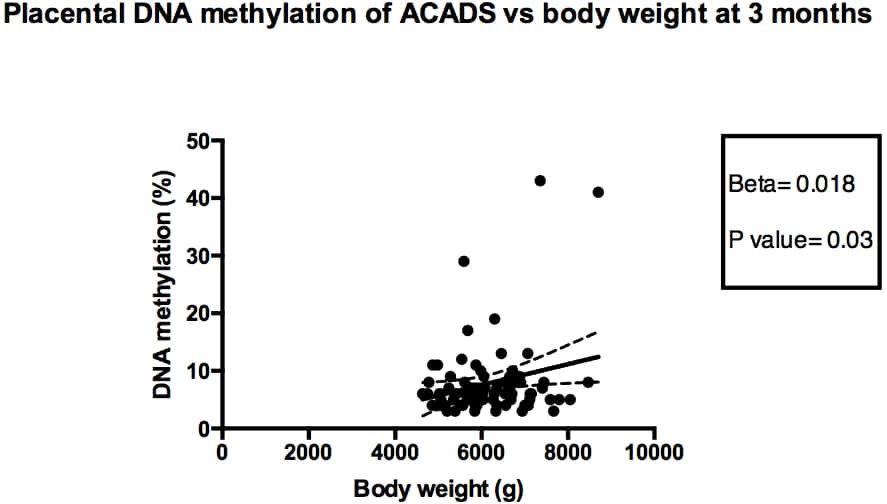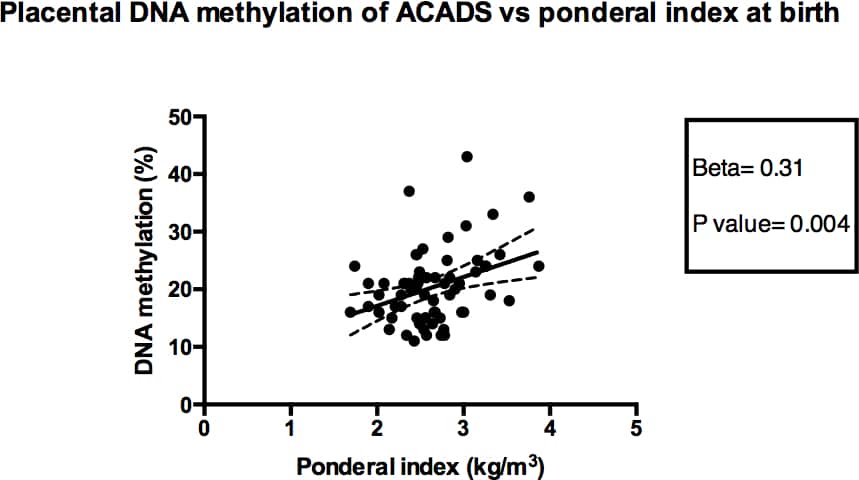Background: Metformin is widely used for treatment of gestational diabetes mellitus, despite crossing the placenta. The limited available data reporting long-term effects for offspring of exposure to metformin in utero show risk of increased adiposity in childhood but mechanisms are unknown. As epigenetic modifications have been proposed as a candidate pathway linking early-life development to later-life obesity, we hypothesised that alterations in placental DNA methylation would be associated with increased adiposity in infants exposed to metformin in utero. Methods: Placental samples were collected at delivery from obese pregnant women (n=104) who participated in the EMPOWaR trial and were randomised to metformin (up to 2.5g daily) vs. placebo from 16 weeks’ gestation until delivery. DNA methylation arrays (Illumina® Infinium HumanMethylation450 BeadChips, USA) were performed on bisulphite-converted DNA (EZ DNA Methylation kit, Zymo Research, UK) extracted from the placenta samples (n=89, n=43 (48.3%) Male, n=45 (50.6%) metformin treated). We tested the association of DNA methylation and metformin treatment with infant size at three months using R programming (CpGassoc package) and adjusted for baby sex and treatment with Holm-Bonferroni adjustment for significance. Two candidate genes (ACADS, acyl-CoA dehydrogenase short chain, a key enzyme in mitochondrial fatty acid beta-oxidation and CYP11A1, Cytochrome P450 Family 11 Subfamily A Member 1, involved in drug metabolism and synthesis of cholesterol, steroids and lipids) were chosen from the significant (Holm.sig= TRUE) top picked CpG sites from Holm-Bonferroni analysis for validation. PCR primers were designed using PyroMark Assay Design Software 2.0 for pyrosequencing. Associations of DNA methylation (%) data were tested with infant size at birth and at three months with adjustment for infant sex. Results: Analysis of array data showed increased placental DNA methylation of ACADS was associated with higher infant weight (cg27246729, p=3.81E-08) and ponderal index (PI) (cg27246729, p= 1.42E-11) at three months of age. DNA methylation at ACADS was further analysed by pyrosequencing: increased DNA methylation at a neighbouring CpG site was positively associated with infant weight (cg10600917, Beta=0.018; p=0.03) at three months and methylation at cg27246729 associated with increased PI at birth (Beta=0.31, p=0.004). Pyrosequencing of CYP11A1 failed to replicate the array findings. Metformin treatment was not associated with placental DNA methylation or infant adiposity. Conclusion Our findings suggest placental DNA methylation of ACADS, a gene involved in key metabolic pathways, is linked to infant size at birth and at three months. Further investigation is needed to understand the relevance of these findings. Metformin exposure was not associated with placental DNA methylation or infant adiposity in this small sample, adding to the literature indicating it is safe to use in pregnancy.
Physiology 2019 (Aberdeen, UK) (2019) Proc Physiol Soc 43, PC201
Poster Communications: Human placental DNA methylation is associated with infant size at birth and at three months, but is not altered by maternal metformin therapy.
L. Yang1, J. Manning2, M. Aldhous3, F. Denison3, J. Norman3, A. Drake1, R. Reynolds1
1. University/British Heart Foundation Centre for Cardiovascular Science, Queen's Medical Research Institute, University of Edinburgh, Edinburgh, United Kingdom. 2. Edinburgh Genomics, University of Edinburgh, Edinburgh, United Kingdom. 3. MRC Centre for Reproductive Health, Queen's Medical Research Institute, University of Edinburgh, Edinburgh, United Kingdom.
View other abstracts by:
Where applicable, experiments conform with Society ethical requirements.


